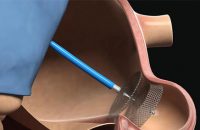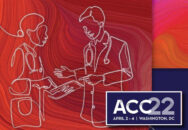The need for permanent pacemaker implantation (PPM) continues to be one of the main challenges in TAVR, especially with self-expanding valves, with a pacemaker implantation rate that varies between 17.5% and 30% in large randomized studies, vs. 4% to 6.5% with self-expanding valves. Therefore, in an attempt to prevent the need for PPM implantation, the…
Heterotopic Tricuspid Intervention: TricValve One-Year Outcomes
Severe tricuspid regurgitation (TR) presents a reserved prognosis when not treated in time, seeing as systemic venous congestion might significantly limit quality of life in these patients. For many years it was thought diuretic therapy was the only option to treat these patients, since the surgical alternative offered suboptimal results and many patients were deemed…
Survival in Patients with Tricuspid Regurgitation According to Clinical and Echocardiographic Variables (Clusters)
Survival analysis of patients with tricuspid regurgitation grouped according to comorbidities and echocardiographic variables. For many years, the tricuspid was classified as the “forgotten valve,” due to the scarce possibility of treatment beyond symptom control in patients with heart failure. However, in recent years, there has been an improvement in the treatment of the valve…
Prognostic Impact of Acute Kidney Injury Following Tricuspid Transcatheter Edge-to-Edge Repair
Tricuspid failure (TF) mostly affects the elderly and, because of this, is associated with comorbidities that increase surgical risk. Tricuspid edge to edge repair (TEER) has surged as a valid alternative for the mitral valve in high-risk patients and, at present, is increasingly being used for tricuspids. One of the complications following TEER is acute…
TRICVALVE in Patients with Severe Tricuspid Regurgitation: Promising Results at 6 months
Severe tricuspid regurgitation (TR) is associated with high mortality and morbidity. For patients with high surgical risk that cannot get surgery, the endovascular option has become an attractive solution this past decade. Transcatheter intervention has focused on edge-to-edge repair and valve replacement. However, their success depends on anatomical characteristics and imaging guidance effectiveness. The bicaval…
Antithrombotic Therapy Post Percutaneous Left Atrial Appendage Closure
Percutaneous left atrial appendage closure (LAAO) with Watchman has FDA approval since March 2015, having shown, in the PROTECT-AF and PREVAIL studies, reduced risk of atrial fibrillation driven stroke, by excluding the left atrial appendage form systemic circulation. Both studies used post procedure standardized protocols involving followup at 45 days and 6 months, imaging, and…
EuroPCR 2022 | CLASP TR Study: Promising Results of Endovascular Intervention of Tricuspid Regurgitation
At present, we are well aware of the rise in mortality caused by severe tricuspid regurgitation (TR). Medical and surgical treatments have turned out to be suboptimal. Hence, endovascular intervention presents as an alternative therapeutic strategy with promising results. The aim of this multicenter, prospective study was to assess the safety and efficacy of the…
EuroPCR 2022 | Real World Outcomes on Edge-to-Edge Tricuspid Valve Repair: 30 Day Outcomes of the TriClip bRight
This study was carried out to assess the safety and efficacy of the TriClip (edge-to-edge repair) in patients with severe tricuspid regurgitation with persistent symptoms despite medical treatment and high surgical risk. It is a prospective multicenter single arm study including 300 patients of mean age 78±7.6; 7.7% presented prior aortic intervention and 28% prior…
EuroPCR 2022 | TriCLASP, Evolution at 30 Days
Tricuspid regurgitation (TR) is difficult to manage and is a mortality predictor. At present, surgery is recommended, even though its mortality rate is not low. Endovascular intervention of this entity is currently being developed and according to the European guidelines, it has evidence level IIb C in symptomatic inoperable patients. The TriCLASP included 74 patients…
EuroPCR 2022 | 1 Year Outcomes of Tricuspid Valve Repair with Cardioband: Feasibility Study
Tricuspid failure is a prevalent valvulopathy most often mistreated. It has been associated with high surgical risk and medical treatment has showed substandard therapeutic effect. Surgical repair with valve annuloplasty is the technique of choice for its long-term durability. Transcatheter repair of the tricuspid valve is an alternative that aims at imitating annuloplasty by reducing…
ACC 2022 | CLASP TR Study: Tricuspid Valve Repair with the PASCAL Device
The study included 65 patients who received endovascular treatment of the tricuspid valve with the PASCAL device. Forty-six completed the 12-month follow-up. At 1-year follow-up, the major events endpoint was 16.9%; the most frequent event was bleeding (9.2%). In addition, there were three cases of stroke, one reintervention, two vascular access complications, and five cardiovascular-related…








